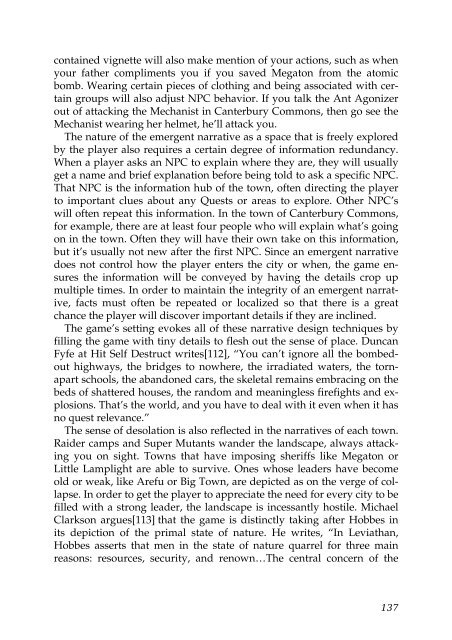Well Played 2.0: Video Games, Value and Meaning - OpenLibra
Well Played 2.0: Video Games, Value and Meaning - OpenLibra
Well Played 2.0: Video Games, Value and Meaning - OpenLibra
You also want an ePaper? Increase the reach of your titles
YUMPU automatically turns print PDFs into web optimized ePapers that Google loves.
contained vignette will also make mention of your actions, such as when<br />
your father compliments you if you saved Megaton from the atomic<br />
bomb. Wearing certain pieces of clothing <strong>and</strong> being associated with certain<br />
groups will also adjust NPC behavior. If you talk the Ant Agonizer<br />
out of attacking the Mechanist in Canterbury Commons, then go see the<br />
Mechanist wearing her helmet, he’ll attack you.<br />
The nature of the emergent narrative as a space that is freely explored<br />
by the player also requires a certain degree of information redundancy.<br />
When a player asks an NPC to explain where they are, they will usually<br />
get a name <strong>and</strong> brief explanation before being told to ask a specific NPC.<br />
That NPC is the information hub of the town, often directing the player<br />
to important clues about any Quests or areas to explore. Other NPC’s<br />
will often repeat this information. In the town of Canterbury Commons,<br />
for example, there are at least four people who will explain what’s going<br />
on in the town. Often they will have their own take on this information,<br />
but it’s usually not new after the first NPC. Since an emergent narrative<br />
does not control how the player enters the city or when, the game ensures<br />
the information will be conveyed by having the details crop up<br />
multiple times. In order to maintain the integrity of an emergent narrative,<br />
facts must often be repeated or localized so that there is a great<br />
chance the player will discover important details if they are inclined.<br />
The game’s setting evokes all of these narrative design techniques by<br />
filling the game with tiny details to flesh out the sense of place. Duncan<br />
Fyfe at Hit Self Destruct writes[112], “You can’t ignore all the bombedout<br />
highways, the bridges to nowhere, the irradiated waters, the tornapart<br />
schools, the ab<strong>and</strong>oned cars, the skeletal remains embracing on the<br />
beds of shattered houses, the r<strong>and</strong>om <strong>and</strong> meaningless firefights <strong>and</strong> explosions.<br />
That’s the world, <strong>and</strong> you have to deal with it even when it has<br />
no quest relevance.”<br />
The sense of desolation is also reflected in the narratives of each town.<br />
Raider camps <strong>and</strong> Super Mutants w<strong>and</strong>er the l<strong>and</strong>scape, always attacking<br />
you on sight. Towns that have imposing sheriffs like Megaton or<br />
Little Lamplight are able to survive. Ones whose leaders have become<br />
old or weak, like Arefu or Big Town, are depicted as on the verge of collapse.<br />
In order to get the player to appreciate the need for every city to be<br />
filled with a strong leader, the l<strong>and</strong>scape is incessantly hostile. Michael<br />
Clarkson argues[113] that the game is distinctly taking after Hobbes in<br />
its depiction of the primal state of nature. He writes, “In Leviathan,<br />
Hobbes asserts that men in the state of nature quarrel for three main<br />
reasons: resources, security, <strong>and</strong> renown…The central concern of the<br />
137

















